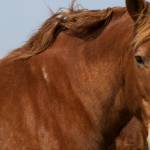Equine Metabolic Syndrome

In 2010, the American College of Veterinary Internal Medicine released its consensus statement regarding equine metabolic syndrome (EMS). The syndrome was first described in 2002 and has many similarities to a comparable condition in humans. For years, veterinarians had recognized that obese young horses were at risk of developing laminitis but only fairly recently has this association been further investigated.
Most horses affected with EMS are overweight and have abnormal fat deposits including cresty necks, fat around the tailhead that makes the tail look inset into the body, and fat pads around the shoulder, sheath, or udder. Affected horses also have insulin resistance, a disorder similar to type 2 diabetes mellitus in humans. If blood work is performed, it may show elevated insulin and blood glucose (sugar) concentrations. Perhaps the most serious and potentially fatal clinical sign of EMS is laminitis that occurs spontaneously without any of the other conditions that can normally result in laminitis such as retained placenta, grain overload, colic, or diarrhea. Affected mares may also have irregular heat cycles.
Horses with EMS are usually described as “easy keepers” that gain or maintain weight with very little feed. Morgans, Paso Finos, Arabians, American Saddlebreds, Spanish Mustangs, Warmbloods, and ponies are commonly affected. Other light breeds can also be affected, although less often. Most horses with EMS are fairly young and are between 5 and 15 years of age.
EMS is believed to be an abnormal adaptation of fat storage. Under normal circumstances fat storage prepares horses for times when food will be scarce. However, fat acts as much more than an energy-storage tissue; it stimulates inflammation and affects insulin metabolism. One important role of insulin is to help drive glucose into cells, where it is used or stored for energy. Normally, insulin encourages blood vessels to relax and become more open, which improves blood flow. Recent research has shown that high blood concentrations of insulin, as occurs in EMS, can actually do the opposite, constricting blood vessels and reducing blood flow. Laminitis often occurs with lush pasture growth during late spring and early summer, when pastures have high sugar content (nonstructural carbohydrates).
Diagnosis of EMS can be difficult and usually also involves ruling out equine Cushing’s disease (ECD). Occasionally, horses can be affected with both conditions, and some researchers speculate that EMS may predispose some horses to develop ECD at an earlier age. Horses with EMS may have elevated blood glucose concentrations, but usually blood glucose is normal or high-normal. Diabetes mellitus is uncommon in horses. High blood insulin concentrations are often present. Normal horses can have elevated insulin concentrations with corticosteroid therapy, pain, or stress. The most reliable tests to accurately determine glucose and insulin responses involve intravenous infusion of glucose and insulin followed by measurement of blood concentrations over time. However, these tests are complicated and not commonly performed, even in hospital settings.
Dietary management of EMS is critical. Like humans, horses will lose weight if they are fed less and exercised more. Owners of affected horses often do not realize they are killing their horses with kindness unless they significantly restrict or eliminate feeding of highly digestible sugars in grain. Quick-growing early-season grasses often cause significant problems for EMS horses, including signs of laminitis. For this reason, when pastures are growing rapidly, it is wise to limit turnout, use a grazing muzzle, or create a drylot. Some EMS horses cannot tolerate unrestricted access to pasture at any time of the year. Ideally EMS-affected horses are fed only mature hay at 1.5% of their body weight per day (15 pounds [7 kg] per 1000 pounds [455 kg] of body weight). If any concentrate is fed, it should be low in starch and high in fiber, and derive most of its calories from beet pulp, hay cubes, vegetable oils, or other sources. It is important to supplement or have ready access to minerals and vitamins because overall feed intake is limited.
Most feeds designed for weight loss in horses will have an increased concentration of minerals and vitamins to make up for decreased intake. If affected horses are sound, as much turnout as possible will encourage exercise and improve insulin sensitivity.
Medical therapy for EMS can involve levothyroxine (thyroid hormone) supplementation and/or metformin. Thyroid hormone supplementation helps affected horses lose weight by increasing their basal metabolic rate and the number of calories they use. Researchers have shown that low-dose levothyroxine supplementation has not produced any adverse effects. Metformin improves the action of insulin, and inhibits glucose production and its metabolism for energy. How well horses absorb metformin is still being investigated, as is its efficacy.
The diagnosis and treatment of EMS is complicated and can vary greatly between horses. Affected horses almost always benefit from severe restriction of grain intake and pasture access during spring and early summer. The best source of information for concerned owners is a veterinarian because ordering and interpretation of diagnostic tests is not straightforward and not all horses will require additional medical therapy.








